Neuro Exam 3
0.0(0)
Card Sorting
1/101
Earn XP
Description and Tags
Study Analytics
Name | Mastery | Learn | Test | Matching | Spaced |
|---|
No study sessions yet.
102 Terms
1
New cards
Steps of synaptic vesicle cycle
1. NT loading
2. Mobilization and targeting
3. Docking
4. Priming
5. Fusion
6. Endocytosis/Recycling
2
New cards
NT loading machinery
vesicular NT transporter (vTransporter)
* pumps NTs into the vesicle by coupling the pumping of protons out of the vesicle
* V-ATPase- pumps protons into the vesicle so the vTransporter can function. Uses ATP hydrolysis
* pumps NTs into the vesicle by coupling the pumping of protons out of the vesicle
* V-ATPase- pumps protons into the vesicle so the vTransporter can function. Uses ATP hydrolysis
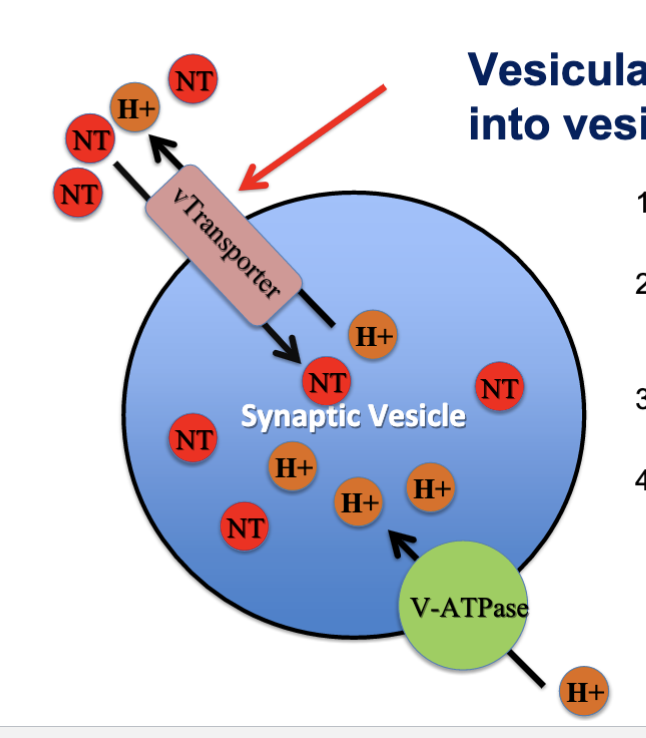
3
New cards
Mobilization and targeting machinery
Synapsins
* regulates movement of vesicle to the active zone by attaching to vesicle and then to actin to position the vesicle.
* CAMK2 - phosphorylates Synapsin in response to Ca2+ so the vesicle can freely move to the active zone
* regulates movement of vesicle to the active zone by attaching to vesicle and then to actin to position the vesicle.
* CAMK2 - phosphorylates Synapsin in response to Ca2+ so the vesicle can freely move to the active zone
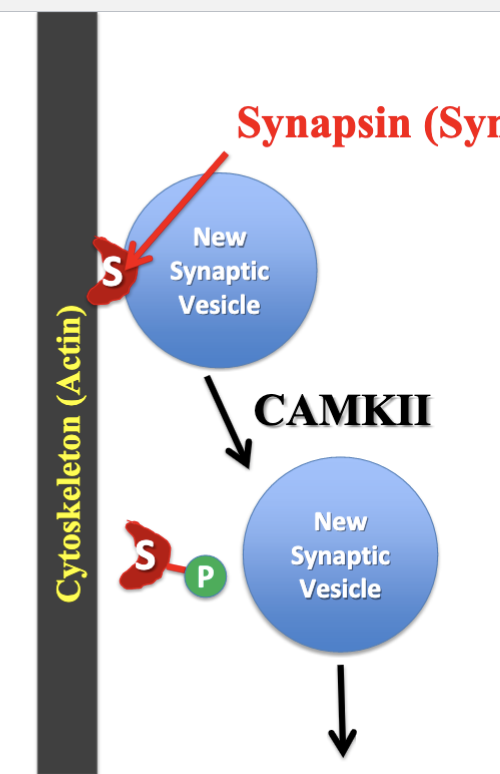
4
New cards
What would genetic deletion of synapsin cause?
Inhibits NT release by reducing the reserve pool (synapses have less vesicles near the active zones so they cannot sustain high rates of release)
5
New cards
Docking machinery
Rab3A = GTP-binding protein that attaches to the vesicle and helps capture it to the active zone
Munc13/RIM = crosslinks with Rab3A to bring the vesicle to the active zone
Munc13/RIM = crosslinks with Rab3A to bring the vesicle to the active zone

6
New cards
What is the consequence of no Rab3A gene?
Enhanced release but have a reduced pool of releasable vesicles
7
New cards
Priming Machinery
SNARE Complex made of one V-SNARE (Synaptobrevin) and two T-SNARES (SNAP 25 and Syntaxin) to create a 4 motif complex
* Active zone membrane contains the T-SNAREs and the vesicle contains the V-SNAREs
* Munc18 is used to stabilize the complex when it comes together at the active zone
* SNARE complex pulls the vesicle and membrane together so they are 2nm apart
* Active zone membrane contains the T-SNAREs and the vesicle contains the V-SNAREs
* Munc18 is used to stabilize the complex when it comes together at the active zone
* SNARE complex pulls the vesicle and membrane together so they are 2nm apart
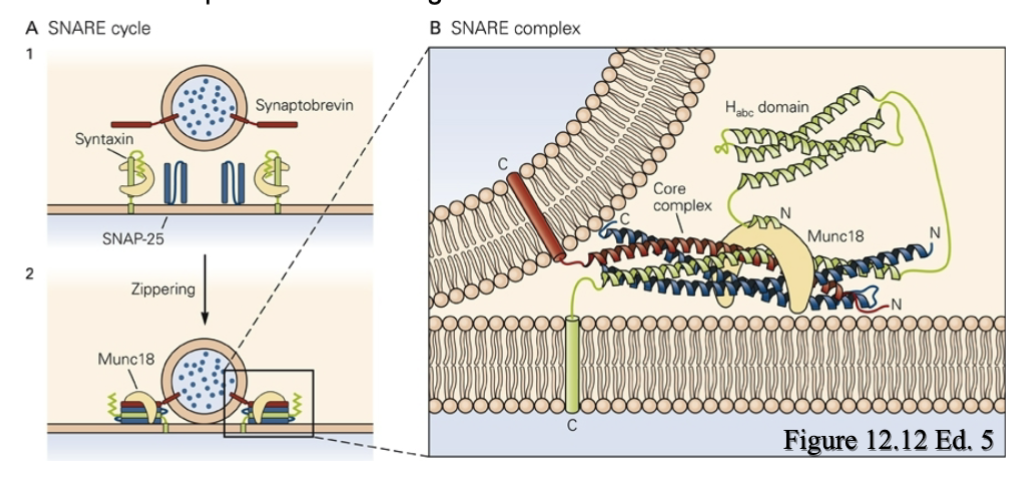
8
New cards
Botulinum
A toxin that cuts the T and V-SNAREs so it would block NT release because there would be no priming and fusion of the vesicle and membrane
9
New cards
Tetanus Toxin
Cuts the V-SNARE and would inhibit NT release because there would be no priming and fusion of the vesicle and the plasma membrane.
10
New cards
What facilitates fusion?
Ca2+ dependent
11
New cards
What happens to the SNARE complex after fusion?
NSF and SNAP 25 disassemble the complex
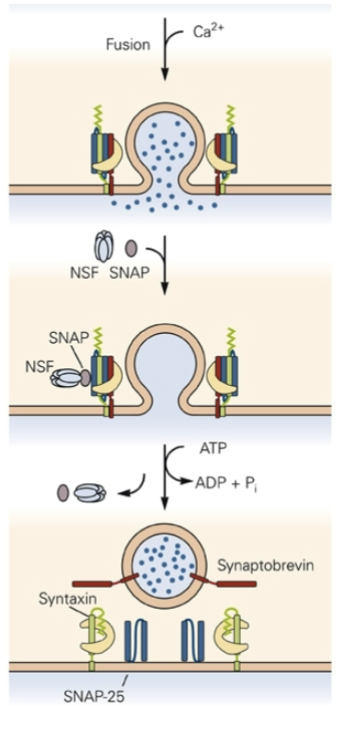
12
New cards
Fusion Machinery
Synaptotagmin = Ca2+ sensor for vesicle-active zone fusion
* transmembrane protein with two Ca2+ binding sites
* when Ca2+ binds and activates the protein, it binds to the SNARE complex and inserts into the active zone
* Dimple forms when the membranes are pulled together and it causes stress that facilitates fusion
* When there is no Ca2+ present, synaptotagmin actually blocks fusion
* transmembrane protein with two Ca2+ binding sites
* when Ca2+ binds and activates the protein, it binds to the SNARE complex and inserts into the active zone
* Dimple forms when the membranes are pulled together and it causes stress that facilitates fusion
* When there is no Ca2+ present, synaptotagmin actually blocks fusion

13
New cards
What does changing the Ca2+ affinity for synaptotagmin do?
Changes the amount of Ca2+ required for both spontaneous and evoked release
14
New cards
Endocytosis/Recycling Machinery
Endosome and plasma membrane transporters (specific for the NT)
15
New cards
What are the three ways to recycle vesicles?
1. Reversible Fusion Pore
2. Clathrin-Mediated
3. Bulk retrieval

16
New cards
Why is it advantageous to have a low affinity calcium sensor for NT release?
A low affinity calcium sensor for NT release gives high signal noise (less background release) and temporal precision (release is restricted to time of peak Ca2+ influx)
17
New cards
NT release is a ___ dependent process
Ca2+ dependent!
18
New cards
What triggers Ca2+ channels to open for NT release?
Ca2+ current follows AP which means membrane depolarization is the trigger to open Ca2+ channels!
* the Ca2+ current peaks after the action potential so VG Na+ channels open faster than Ca2+ channels
* the Ca2+ current peaks after the action potential so VG Na+ channels open faster than Ca2+ channels
19
New cards
What is the speed of Ca2+ inactivation and why?
Slow, to allow more Ca2+ entry
20
New cards
__ triggers the postsynaptic current
NT triggers the postsynaptic current
21
New cards
How much intracellular Ca2+ is needed to trigger the Ca2+ sensor? (threshold?)
about 50 μM
22
New cards
What is the relationship between NT release and Ca2+ flux?
NT release shows steep, non-linear dependence on Ca2+ influx for NT release. Ex: a 2-fold increase in Ca2+ influx could make a 16-fold increase in NT release
23
New cards
What shows evidence that the Ca2+ sensors have low Ca2+ affinity?
most Ca2+ dependent enzymes only need 1 μM for full occupancy of Ca binding
24
New cards
What ceases NT release in regards to the Ca2+ channels?
when the concentration of Ca2+ reaches below the threshold
25
New cards
How are presynaptic Ca2+ channels arranged?
In rows that are localized at active zones so that Ca2+ influx can occur at the site where it is needed
ex: at NMJ, presyn. Ca2+ channels line up with postsyn. ACh receptors
ex: at NMJ, presyn. Ca2+ channels line up with postsyn. ACh receptors
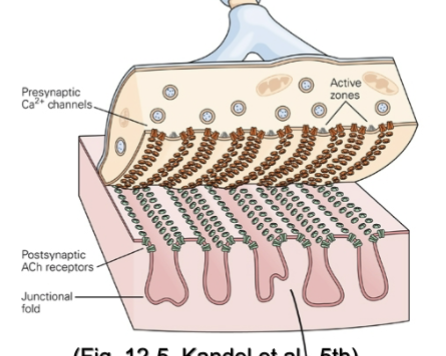
26
New cards
What are some things that can cause a decrease in Ca2+ concentration?
1. greater distance from VG Ca2+ channels means less Ca2+
2. Ca2+ is rapidly buffered by binding proteins, mito uptake and pumps that dump it back outside the terminal
27
New cards
How can sustained Ca2+ entry cause synaptic potentiation?
During high frequency stimulation, there is so much Ca2+ that flows into the axon terminals that the buffering systems become saturated which leads to the buildup of residual Ca2+.
The residual Ca2+ becomes a second messenger that activates Ca2+ dependent enzymes (ex: CAMKII) which then increase vesicle release in response to subsequence action potentials → thus synaptic potentiation
\
Each presynaptic AP will cause a bigger PSP
\
Can last seconds to hours
The residual Ca2+ becomes a second messenger that activates Ca2+ dependent enzymes (ex: CAMKII) which then increase vesicle release in response to subsequence action potentials → thus synaptic potentiation
\
Each presynaptic AP will cause a bigger PSP
\
Can last seconds to hours
28
New cards
What are the 4 types of VG Ca2+ channels? What is their function?
P/Q - fast release
N - fast release
L - slow release and muscle contraction
T - excitability
N - fast release
L - slow release and muscle contraction
T - excitability
29
New cards
ω-agatoxin
Blocks P/Q type Ca2+ channels
30
New cards
ω-conotoxin
blocks N type Ca2+ channels
31
New cards
Dihydropyridines
block L type Ca2+ channels
32
New cards
Mibefradil
Blocks T type Ca2+ channels
33
New cards
Spontaneous NT release is ____
Spontaneous NT release is quantal
34
New cards
Quantal NT release hypothesis
spontaneous fusion of single synaptic vesicle releases a fixed amount of NT which will open a few ligand gated ion channels, which will cause the fixed small depolarization event
35
New cards
Mini/mEPSP
Spontaneous Miniature Postsynaptic Potential
* “The minimum response that a neuron will respond to that produces a depolarization event that is uniform in size”
* A spontaneous event
* One quantum = one vesicle with NT
* Minis occur at all chemical synapses but cannot fire an AP because they are too small
* The total postsynaptic potential is made up of a large number of quantal potentials. The total EPSP looks smooth because there are so many minis
* “The minimum response that a neuron will respond to that produces a depolarization event that is uniform in size”
* A spontaneous event
* One quantum = one vesicle with NT
* Minis occur at all chemical synapses but cannot fire an AP because they are too small
* The total postsynaptic potential is made up of a large number of quantal potentials. The total EPSP looks smooth because there are so many minis
36
New cards
What presynaptic and postsynaptic factors could change the size of a mini?
Presynaptic Factor – increasing the amount of NTs in the vesicle increases quantal size and increases the amplitude of the mEPSP
Postsynaptic Factor – increasing receptors in the post synapse can increase the amplitude of the mEPSP
Postsynaptic Factor – increasing receptors in the post synapse can increase the amplitude of the mEPSP
37
New cards
What does increasing Ca2+ concentration do to quantal release?
Vesicles are packaged with a fixed amount of NT (quantum) and increasing or decreasing the Ca2+ influx will not change the size of the quantum, bur rather the rate of quantal release.
\
More Ca2+ concentration = more quantal will be released = more vesicles fuse and release NT
\
More Ca2+ concentration = more quantal will be released = more vesicles fuse and release NT
38
New cards
What factors can change the amount of NT release?
* # of individual synapses between a pair of pre and post cells
* the number of active zones in the synaptic terminal
* the probability that a presynaptic AP will trigger release of one or more quanta of NT at an active zone
* the number of active zones in the synaptic terminal
* the probability that a presynaptic AP will trigger release of one or more quanta of NT at an active zone
39
New cards
How does capacitance change during NT release?
NT release will cause a brief increase in capacitance of the nerve terminal when it fuses because the surface area of the nerve terminal will increase slightly. Capacitance is directly proportional to surface area, so as surface area increases, so does capacitance.

40
New cards
What are 3 methods to detect NT release?
1. Capacitance
2. Electrochemical detection with Voltammetry
3. Optical Biosensors
41
New cards
Detecting NT release with Voltammetry
a large amount of voltage is applied to the tip of an electrode, which will oxidize certain NTs. The oxidation of the NTs generates free elections. The current of these electrons is proportional to the amount of NT released, so it can be measured and quantified (OLD METHOD)

42
New cards
Detecting NT release with Optical Biosensors
measure NT release with electrochemical detection and light. Using fluorescence to see what and how much NT is in the synapse. KLight is a receptor that only fluoresces when an agonist (the NT) is bound. It is a GPCR and when the NT binds, it will change shape so that it will emit light.
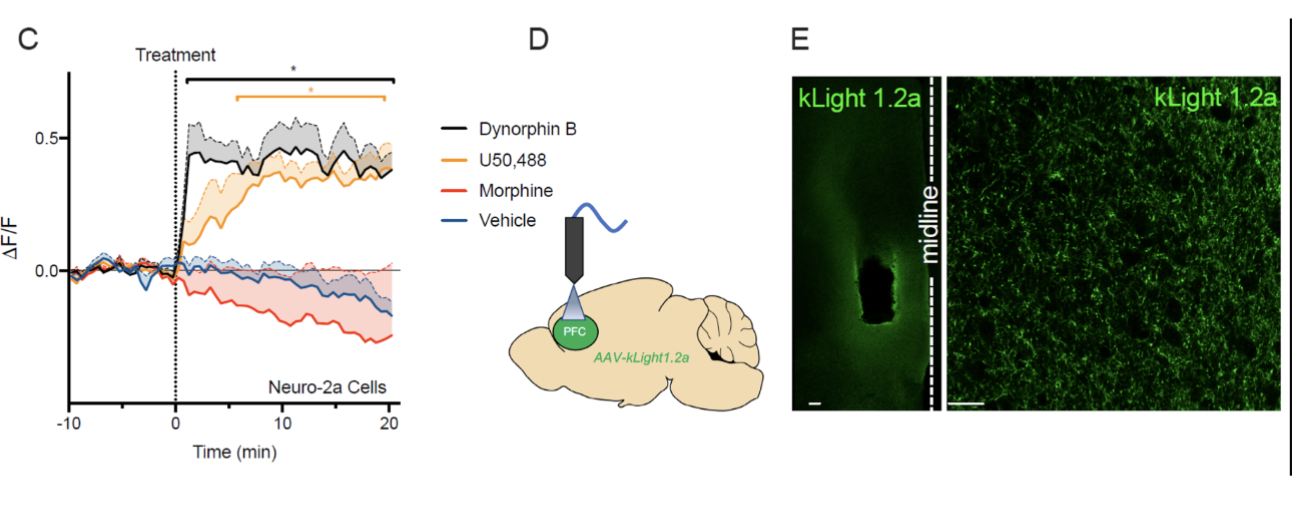
43
New cards
Why is recycling vesicles important?
Helps to prevent the supply of vesicles being rapidly depleted during a fast synaptic transmission
44
New cards
What is the standard release pathway for NT release at active zones?
Complete fusion - clathrin mediated or ultrafast bulk retrieval
45
New cards
State the precursors for the following classical NTs:
* Acetylcholine
* Dopamine
* Norepinephrine
* Epinephrine
* Serotonin
* Histamine
* Glutamate
* Glycine
* GABA
* Acetylcholine
* Dopamine
* Norepinephrine
* Epinephrine
* Serotonin
* Histamine
* Glutamate
* Glycine
* GABA
* Choline
* tyrosine
* tyrosine via dopamine
* tyrosine via norepinephrine
* tryptophan
* histidine
* glutamine
* serine
* glutamate and then by glutamic acid decarboxylase (GAD)
* tyrosine
* tyrosine via dopamine
* tyrosine via norepinephrine
* tryptophan
* histidine
* glutamine
* serine
* glutamate and then by glutamic acid decarboxylase (GAD)

46
New cards
What are the biogenic amines?
Catecholamines (dopamine, norepinephrine, epinephrine)
Serotonin
Histamine
Serotonin
Histamine
47
New cards
What are the amino acid NTs
GABA
Glycine
Glutamate
Glycine
Glutamate
48
New cards
What makes ACh different than the other classical NTs?
It is the only classical NT that is neither an amino acid or derived from one
49
New cards
Life Cycle of Glutamate
1. glial cell reuptakes glutamate by transporter (EAAT/GLT1)
2. Glutamate (Glu) is converted to Glutamine (Gln) in glial cell
3. Neuron converts it back to Glutamate by glutaminase (PAG) in the mitochondria
4. Glu loaded into vesicle by VGluT1-3 and then back out into the synapse
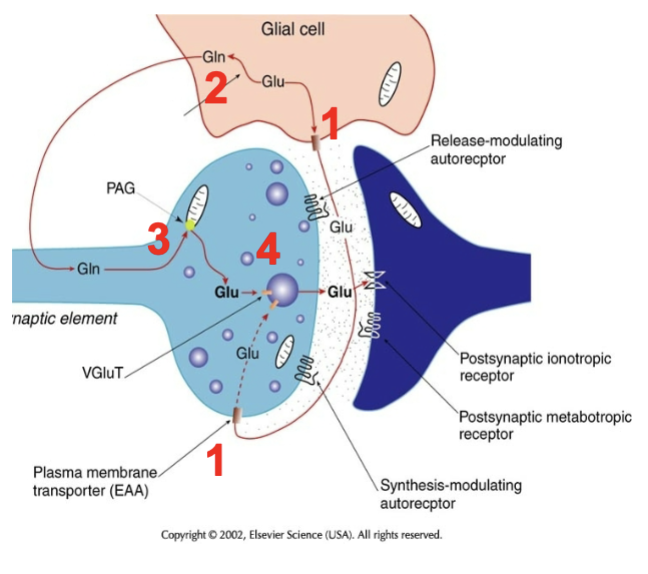
50
New cards
Life Cycle of GABA
1. Glutamate --GAD--→ GABA in neuron and then released into synapse
2. glial cells take up GABA and convert it back to Glu then to Gln
3. Neuron converts Gln back to Glu then back to GABA
4. Packaged into vesicles by transporter (VGAT)
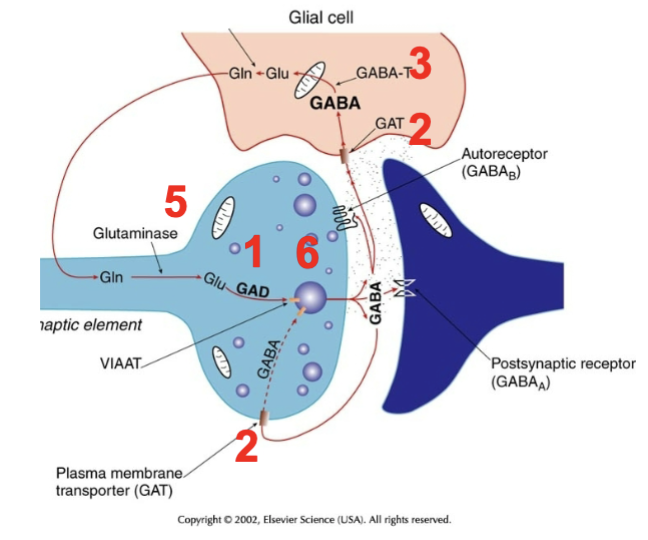
51
New cards
Which of the following are proteins you would need to express in a Glutamatergic neuron to convert it to a GABAergic neuron?
\n A) GAD \n B) Glutaminase \n C) VIAAT + GAD \n D) GABA-T + VIAAT + GAD \n E) VIAAT + GAD + GAT
\n A) GAD \n B) Glutaminase \n C) VIAAT + GAD \n D) GABA-T + VIAAT + GAD \n E) VIAAT + GAD + GAT
C
52
New cards
How is acetylcholine made?

53
New cards
Life Cycle of ACh
1. Made by Chat in the neuron
2. packaged into vesicles by choline transporter
3. released into synapse
4. action is terminated by ACh esterase (AChE) that splits ACh into choline and acetic acid
5. Neuron takes up the choline with choline transporter
\
GLIAL CELLS NOT USED FOR REUPTAKE

54
New cards
If astrocytes are not needed for recycling Ach, why are they \n present at cholinergic synapses?
\n A) They must process co-released Glu \n B) They still need to metabolically support the neurons \n C) They respond to Ach
\n A) They must process co-released Glu \n B) They still need to metabolically support the neurons \n C) They respond to Ach
B
55
New cards
What are three major functions of Cholinergic neuron projections?
1. Motor gating
2. learning and memory
3. motor output
56
New cards
Explain the pathway of synthesis of Dopamine, Norepinephrine and Epinephrine
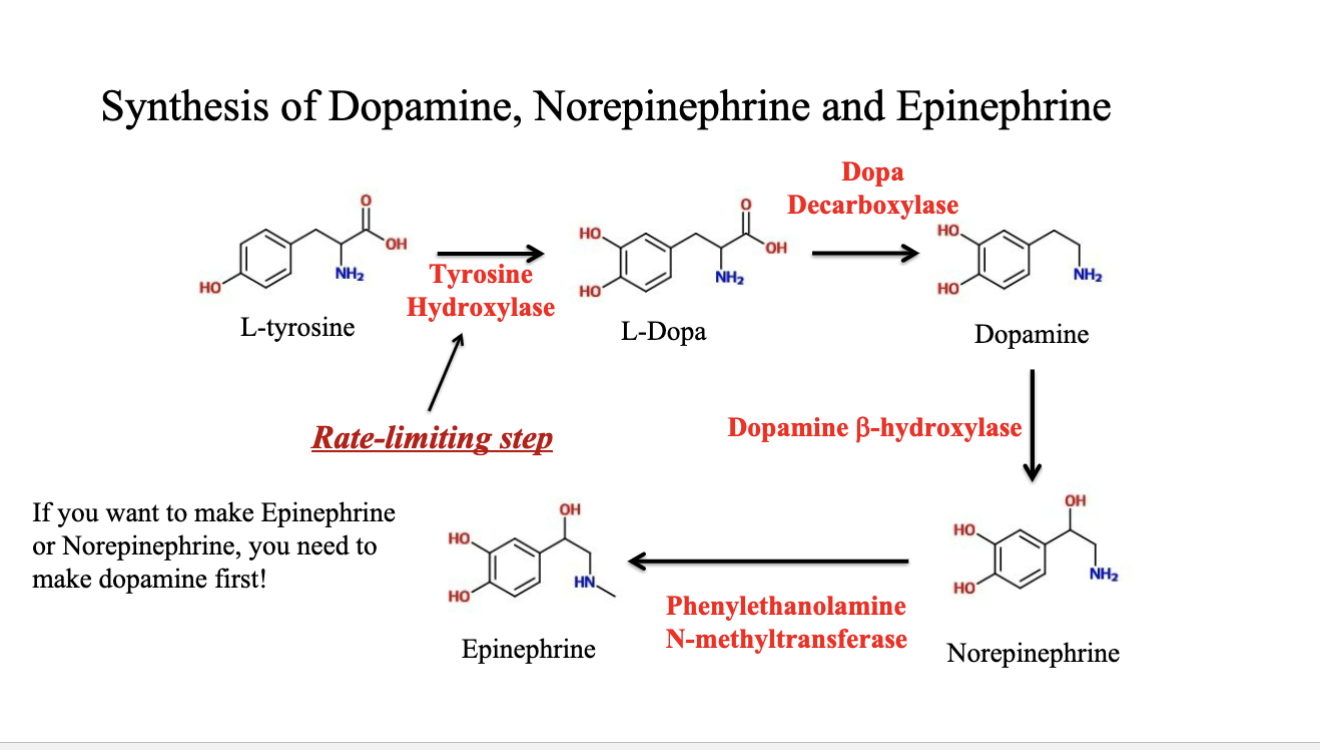
57
New cards
How can you use unique proteins to identify neurons that release specific NTs?
Looking at enzymes that make certain NTs can help you distinguish which neuron it is
Ex: Adrenergic neurons (release norepinephrine and epinephrine) will have the dopamine β-hydroxylase enzyme that converts dopamine to norepinephrine
Ex: Adrenergic neurons (release norepinephrine and epinephrine) will have the dopamine β-hydroxylase enzyme that converts dopamine to norepinephrine
58
New cards
Life Cycle of DA and NE
1. L-tyrosine converted to L-Dopa and then to Dopamine and then if DBH is present, then NE will be made (DBH only in adrenergic neurons)
2. When DA or NE is released they can act on both pre or post neuron receptors
3. Reuptake back into the presynaptic neuron done by either DAT for DA or NET for NE
4. NTs are packaged into vesicles by VMAT/VMAT2 (same for both NE or DA)
5. NTs are degraded by MAO (monoamine oxidase) in the mitochondria
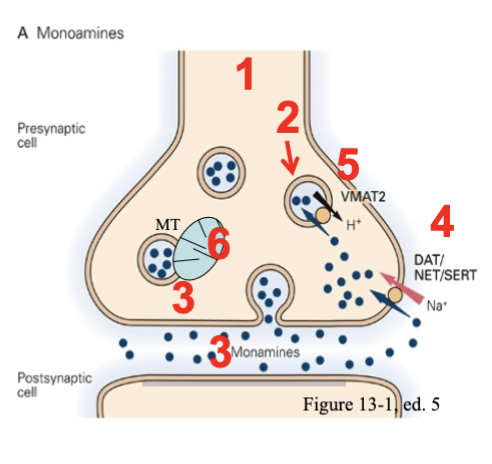
59
New cards
What drives the plasma membrane transporters for reuptake?
Driven by the Na+ electrochemical gradient through a symport mechanism in which Na+ ions and the transmitter move in the same direction (back into the presynaptic neuron from the cleft)
60
New cards
The NE system is a major target for what disorder?
ADHD
61
New cards
Serotonin Synthesis

62
New cards
Life Cycle of Serotonin (5-HT)
1. Synthesized in neuron
2. released into cleft and can act on pre or post receptors
3. Reuptake is with the plasma mem. transporter SERT
4. Packaged back into vesicles with VMAT/VMAT2
5. Degraded by MAO in mitochondria
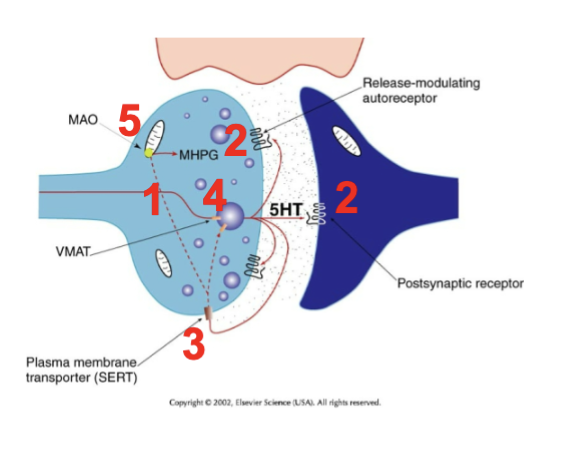
63
New cards
What type of compound specifically targeting the \n serotonin system might alleviate depression?
\n A) SERT inhibitor \n B) Tryptophan \n C) Serotonin receptor blockers \n D) MAO inhibitor \n E) Tryptophan hydroxylase inhibitor
\n A) SERT inhibitor \n B) Tryptophan \n C) Serotonin receptor blockers \n D) MAO inhibitor \n E) Tryptophan hydroxylase inhibitor
D
64
New cards
If you wanted to elevate Dopamine in the synaptic cleft without affecting Norepinephrine, which or the following would you do?
\n A) Inhibit MAO \n B) Provide L-Dopa \n C) Stimulate VMAT \n D) Block DAT
\n A) Inhibit MAO \n B) Provide L-Dopa \n C) Stimulate VMAT \n D) Block DAT
D
65
New cards
What type of receptors do neuropeptides bind to?
GPCRs!
66
New cards
What would happen if NT is left in the synaptic cleft for longer than it should?
Leaving NT in the synapse would initially boost the signal but then prevent new signals from getting through because there would be receptor desensitization (decreased responsiveness of the receptor due to repeated exposure to the agonist)
67
New cards
Neuropeptides
Short polymers of amino acids that are work as a signaling mechanism that works in conjunction with NTs
They are made by neurons and processed in the golgi where they are packaged into dense core vesicles
They are made by neurons and processed in the golgi where they are packaged into dense core vesicles
68
New cards
What are the three rules to classify a neuropeptide?
1. made by neurons
2. stored and released on demand
3. modulate neuronal function via receptors (GPCRs)
69
New cards
What are some examples of neuropeptides?
* opioids
* neuropeptide Y (mediates anti-stress response)
* Somatostatin (SST)
* Corticotropin releasing factor (CRF)
* neuropeptide Y (mediates anti-stress response)
* Somatostatin (SST)
* Corticotropin releasing factor (CRF)
70
New cards
Which neurons release neuropeptides?
probably all of them
71
New cards
Co-transmitter
when more than one transmitter is present in a nerve terminal
there is increasing evidence that many neurons actually release more than one type of NT
there is increasing evidence that many neurons actually release more than one type of NT
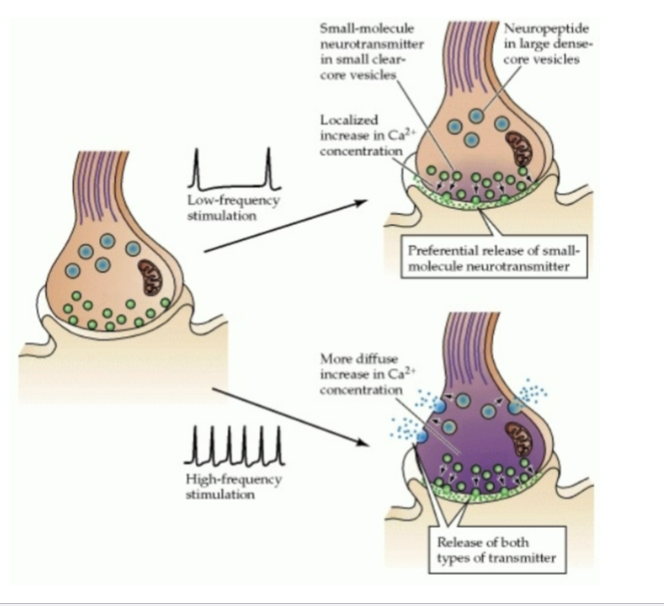
72
New cards
What are the benefits of co-transmisison?
Having more than one transmitter leads to versatility to synaptic transmission. Different frequencies of stimulation can cause the release of one or both transmitters which affects transmission.
73
New cards
What is co-transmission governed by?
The differential release of co-transmitters is based on the distribution of Ca2+ and vesicles in presynaptic terminals.
\
Low firing frequency, the concentration of Ca2+ only causes some opening of local Ca2+ channels so only NT is released
\
High firing frequency causes the Ca2+ concentration to be more evenly distributed throughout the presynaptic terminal, thereby inducing the release of neuropeptides as well
\
Low firing frequency, the concentration of Ca2+ only causes some opening of local Ca2+ channels so only NT is released
\
High firing frequency causes the Ca2+ concentration to be more evenly distributed throughout the presynaptic terminal, thereby inducing the release of neuropeptides as well
74
New cards
List the differences between classical NTs and neuropeptides based on:
* where they are made
* what they are packaged in
* how they are released from the neuron
* reuptake?
* What receptors they activate
* How long/fast their effect is
* where they are made
* what they are packaged in
* how they are released from the neuron
* reuptake?
* What receptors they activate
* How long/fast their effect is
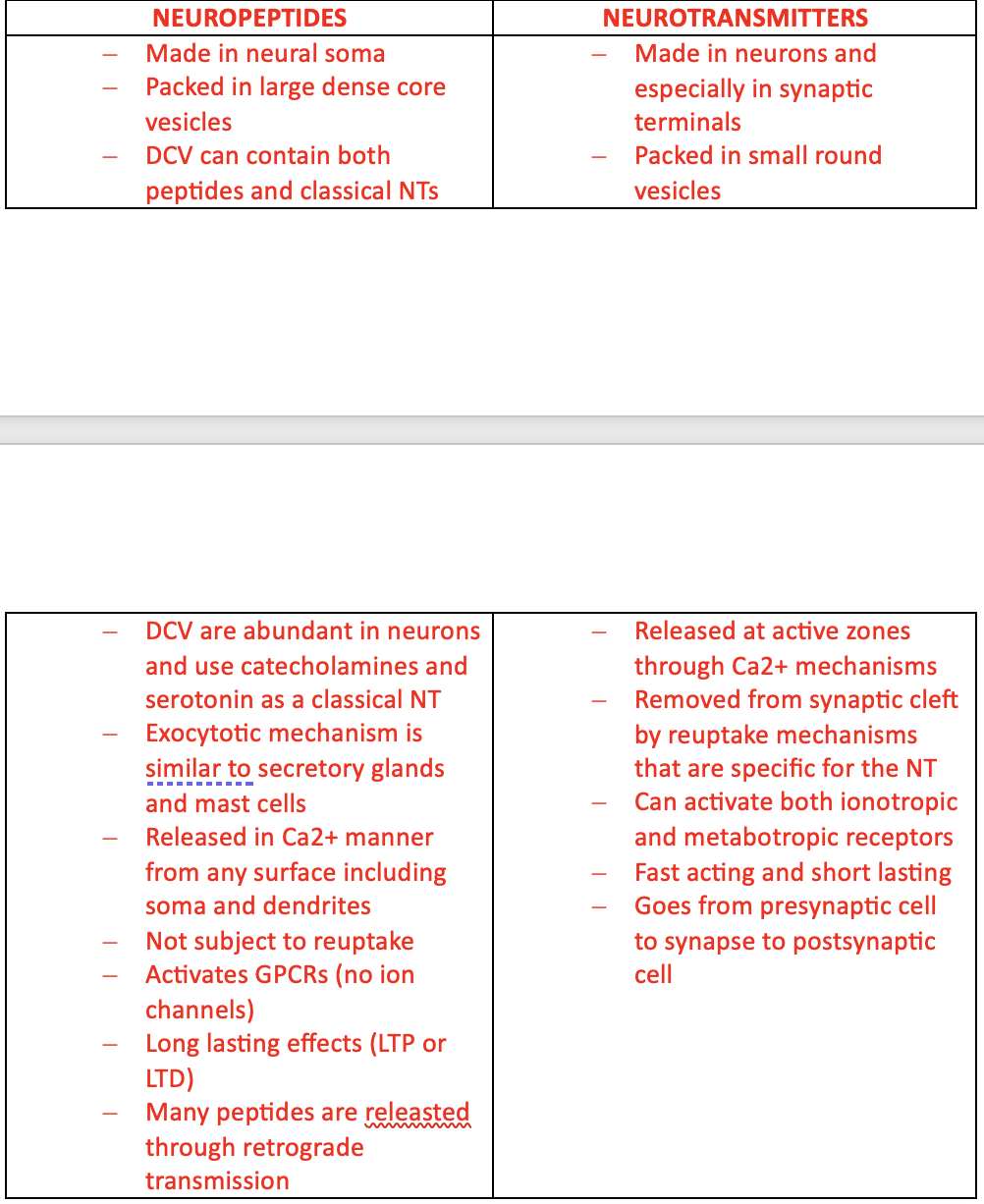
75
New cards
What are the 5 ways to measure neuropeptides?
1. Slice electrophysiology = use voltage clamp to measure EPSP and apply different drugs to see what it does
2. Optically = stimulate the peptide expressing neuron to measure what is being produced
3. Stimulate the peptide-expressing neuron, show it influences something, and show it is mediated by the peptide receptor system
4. Optogenetically stimulate the peptide neuron, microdialysis in vivo
5. Optical biosensor
76
New cards
What NTs are used to treat ADHD and depression?
biogenic amines (dopamine, norepinephrine, and epinephrine)
77
New cards
How does ADHD treatment work with NTs?
* Target NE
* NE signaling focuses attention
* Increasing NE signaling can increase attention and focus
* NE signaling focuses attention
* Increasing NE signaling can increase attention and focus
78
New cards
How does Adderall work?
Acts as VMAT that is designed to increase DA/NE signaling with minimal depletion. To increase attention for patients with ADHD
79
New cards
What is Ritalin and how does it work?
Used to treat ADHD. Directly blocks DAT and NET so there is no reuptake and the NTs stay in the cleft longer
80
New cards
What is the main target for depression treatment?
Serotonin because it signals events to elevate mood and motivation
81
New cards
What are the negative effects of upregulation of dopamine signaling with illegal drugs?
* addiction
* depletion of DA reserves
* increased DA cycling = oxidative stress in neurons which can lead to degeneration
* depletion of DA reserves
* increased DA cycling = oxidative stress in neurons which can lead to degeneration
82
New cards
What are the negative effects of upregulation of NE signaling with illegal drugs?
* NE increases blood pressure and heart rate and can lead to heart attack
* oxidative stress and losing ability to focus
* oxidative stress and losing ability to focus
83
New cards
What are the negative effects of upregulation of serotonin signaling with illegal drugs?
* depletion leads to profound loss of motivation and can cause depression
* oxidative stress
* oxidative stress
84
New cards
Oligodendrocytes
Formation of myelin in CNS
85
New cards
Schwann Cells
Formation of myelin in PNS
86
New cards
Astrocytes
Metabolic and structural support in CNS
87
New cards
Satellite Cells
Metabolic and structural support in PNS
88
New cards
Microglia
Support Innate immunity in CNS
89
New cards
What glial cells are derived from the neural tube? the neural crest?
Neural tube - oligodendrocytes and astrocytes
Neural crest - schwann cells and satellite cells
Neural crest - schwann cells and satellite cells
90
New cards
What is myelin?
Made of oligodendrocytes or Schwann cells and wraps around axons to increase the propagation of APs. It acts as an electrical insulator that prevents charge from leaking out of the axon, which prevents the decrease of the AP conduction
91
New cards
What is the ratio of oligodendrocytes and Schwann cells to the axon?
1 oligodendrocyte : 50 axons
1 Schwann cell : 1 axon
1 Schwann cell : 1 axon
92
New cards
How does myelin increase the speed of AP propagation?
Increases the rate of passive spread of depolarization because it acts as an insulator
93
New cards
Nodes of Ranvier
Non-myelinated portions of the axon that contain clusters of Na+ channels (which generate APs)
* The nodes are easily excitable and give the AP a “boost” when they travel down the axon so that propagation can continue and does not decrease
* The signal jumps from node to node (Saltatory Conduction)
* The nodes are easily excitable and give the AP a “boost” when they travel down the axon so that propagation can continue and does not decrease
* The signal jumps from node to node (Saltatory Conduction)
94
New cards
Guillain-Barre Syndrome
A rare, autoinflammatory disease involving demyelination of peripheral nerves
* less than 10% mortality
* caused by Zika virus
* less than 10% mortality
* caused by Zika virus
95
New cards
Multiple Sclerosis
An autoimmune disease involving demyelination in the CNS
* may be triggered by environmental factors like stress
* patients have decreased motor skills because there is no connections between neurons, especially motor regions
* may be triggered by environmental factors like stress
* patients have decreased motor skills because there is no connections between neurons, especially motor regions
96
New cards
Astrocyte Functions
Homeostasis
* store glycogen for energy
* produce growth factors for neuronal survival
* regulate blood flow
Neurotransmission
* NT metabolism
* gliotransmission
Contribute to response to injury and infection
* store glycogen for energy
* produce growth factors for neuronal survival
* regulate blood flow
Neurotransmission
* NT metabolism
* gliotransmission
Contribute to response to injury and infection
97
New cards
Why is removing glutamate from the synapse with astrocytes important?
Excess glutamate in the synapse can cause epilepsy and Schizophrenia
98
New cards
How do astrocytes help regulate blood flow?
Astrocytes have endfeet on the ends of their processes that bind to the blood vessels
* Ca2+ influx stimulates the astrocyte and they can help with vasodilation and contraction
* Ca2+ influx stimulates the astrocyte and they can help with vasodilation and contraction
99
New cards
How do astrocytes respond to injury or disease?
* stimulated by factors that are secreted from microglia or macrophages
* clear dead cells and form glial scar tissue
* secrete cytokines and chemokines
* clear dead cells and form glial scar tissue
* secrete cytokines and chemokines
100
New cards
Structure of microglia
Many processes around the cell and the cell moves in circles scanning the environment for injury